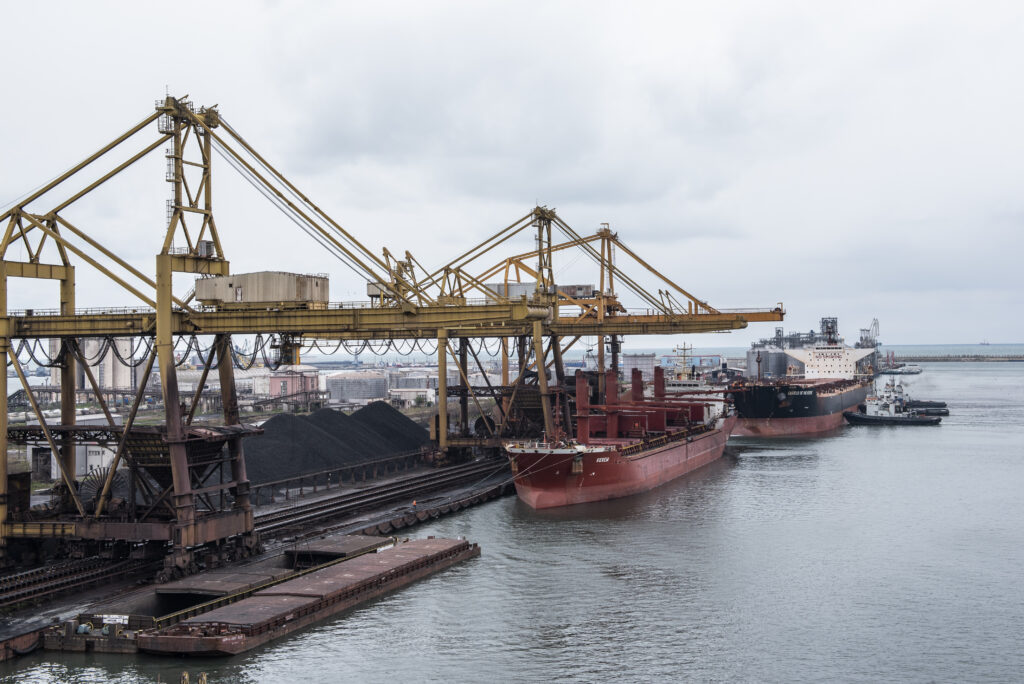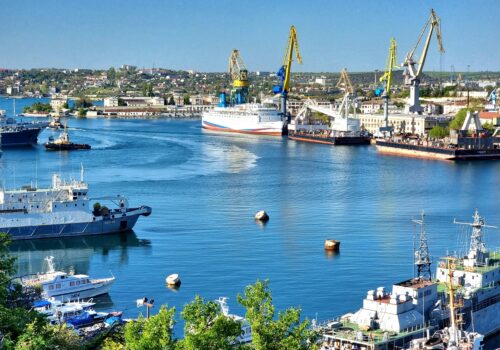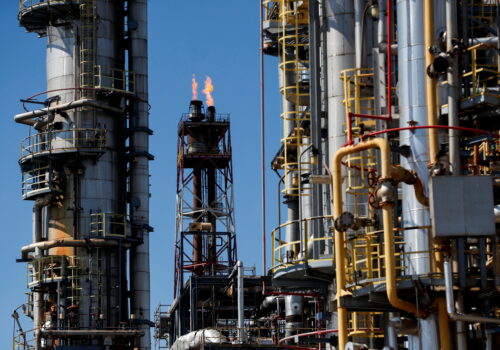The recent US-European Union (EU) trade agreement will not have a uniform impact across Europe. In Paris and Berlin, the accord received a lukewarm reception, and, in some instances, sharp criticism. For Romania, in particular, the picture is more complex. It is an industrialized economy with significant technological advancement and economic complexity, but it is particularly vulnerable to external shocks. While the deal poses certain risks, however, this moment of disruption creates an opportunity for Romania to leverage its unique energy profile to increase competitiveness, advance its industrial development and defense sector, and grow its regional influence.
Details of the deal
The deal, which succeeded in easing trade tensions and averted a tariff war, places a 15 percent base tariff on most EU goods entering the United States, while select goods that Romania trades in (including aircraft, chemicals, pharmaceuticals, and semiconductor equipment) fall under a zero-for-zero tariff agreement or revert to pre-January tariff levels. In return, the EU has agreed to buy US products—including $750 billion worth of energy—and invest $600 billion in the United States. The terms have led many in Europe to worry that they disproportionately favor US interests, disadvantage EU industry, and expose member states to economic risks from reduced export competitiveness, price pressures, and increased US competition within the EU market.
For Romania, the risks from the deal lie less in the direct exposure of its firms to the US market and more from the country’s deep integration within European supply chains. The United States accounts for less than 2 percent of Romania’s total trade, while over 70 percent is with EU partners. Key Romanian exports, including electrical and electronic equipment, vehicles and machinery, depend heavily on close ties with major Western European manufacturers. If increased US tariffs cause EU exporters lose ground in the US market, Western European firms may be forced to cut back production or rethink their sourcing strategies, and Romanian inputs could be displaced from regional networks. Moreover, EU firms could face additional pressure if US producers outcompete them in the single market due to fewer tariffs and regulatory hurdles.
To make matters trickier, EU producers are still grappling with high energy prices, which impact their ability to remain competitive in energy-intensive industries. Liquefied natural gas (LNG) costs significantly more than pipeline gas, and it now accounts for over 50 percent of total EU gas imports, compared to just 23 percent in 2021. Moreover, US LNG, which is generally more expensive than LNG from any other supplier, accounts for 55 percent of EU LNG imports. Energy-intensive sectors in the EU face a clear competitive disadvantage against their US counterparts, which benefit from access to cheaper domestically produced natural gas.
However, Romania can turn these challenges into advantages to stabilize and protect its economy and capitalize on growing demand for new opportunities in transatlantic trade.
Leveraging Romanian energy
With Romanian supply chains vulnerable to shifting global trade dynamics, Romania has a clear incentive to double down on developing its energy sector to buffer its economy against potential disruptions.
The EU’s $750 billion energy commitment under the trade deal underscores the importance of energy for both sides, as well as the urgent need for reliable and affordable energy in Europe as it moves away from Russian supply. The various zero-for-zero tariffs also encourage restructuring supply chains in energy-intensive industries, such as semiconductors, defense, aerospace, and critical minerals, which are central to strategic competition in the 21st century. These sectors will rely on both more efficient and modernized fossil fuel systems as well as domestically generated clean energy to enhance long-term competitiveness and resilience and meet EU climate and diversification goals.
Romania is well positioned to meet these needs and to protect its own economic stability with its unique mix of energy assets and its location at the crossroads of key European energy routes. Its significant access to Black Sea gas reserves can complement US-sourced LNG imports from the United States and other suppliers that could link to EU markets through the Vertical Gas Corridor. Even as clean energy technology is developed to support the long-term goal of net-zero emissions, natural gas will continue to serve as a transition fuel that supports hard-to-abate heavy industry, strengthens energy security, and maintains industrial competitiveness. By investing in efficiency upgrades and affordable solutions for the supply, transportation, and infrastructure development of natural gas, Romania can expand its role in the energy market and stabilize its economy in the process.
Moreover, Romania is expanding its nuclear capacity with new conventional and small modular reactors, with support from US Export-Import Bank financing, US Trade and Development Agency grants, and partnerships with US firms. This approach aligns closely with the trade deal’s focus on nuclear technology within the EU energy purchase pledge and signals significant opportunities for Romania to deepen transatlantic cooperation and accelerate its nuclear development moving forward.
Further capitalizing on its energy resources, Romania is expanding its renewable capacity in hydropower, solar, wind, and green hydrogen, positioning itself to access EU financial support through the Green Deal and REPowerEU. This approach, which aims to surpass the EU target of 40 percent renewable energy consumption by 2030, promotes economic growth and job creation, modernizes its energy infrastructure, and develops integrated grids to support future electrification.
By leveraging its abundant energy resources and potential, Romania can play a critical role both domestically and within the EU, with far reaching impacts. By driving energy access, development, and security, Romania can boost overall production capacity and strengthen regional supply chains. It can also provide a sustainable foundation for growing its domestic energy-intensive sectors, especially its defense industry, a strategic priority given Romania’s role on NATO’s eastern flank. This would attract additional US and EU investment in Romanian military production, modernization, and mobility, which would further sustain the country’s economic stability.
Romania as a strategic energy hub
The US-EU trade deal reshapes the transatlantic economic playing field, and Romania must act decisively to turn expected challenges into long-term advantages. Increased competition and shifting supply chains within the EU present real risks. In response, Romania, with the EU’s support, should leverage its unique energy assets and strategic location, which offer a way to stabilize and grow its economy at a time of increased demand for reliable, regionally sourced, and clean energy. With a focused and proactive hybrid strategy for advancing nuclear, fossil, and renewable energy, Romania can transform this moment of uncertainty into a catalyst for sustainable growth as a multisource energy producer and exporter as well as a strategic energy transit hub.
Uliana Certan is a Program Assistant at the Atlantic Council Global Energy Center
STAY CONNECTED
Sign up for PowerPlay, the Atlantic Council’s bimonthly newsletter keeping you up to date on all facets of the energy transition
OUR WORK

The Global Energy Center develops and promotes pragmatic and nonpartisan policy solutions designed to advance global energy security, enhance economic opportunity, and accelerate pathways to net-zero emissions.
MEET THE AUTHOR
RELATED WORK
Image: A pier for loading and unloading minerals inside Comvex facilities at the port of Constanta, the largest port of the Black Sea, Constanta, Romania, April 2022. The port which expanded to its current size during the communist regime times, and is well connected to the Danube river through a canal, it has never been used in its full capacity. Un quai pour le chargement et le dechargement de mineraux a l interieur des installations de Comvex au port de Constanta, le plus grand port de la mer Noire, Constanta, Roumanie, avril 2022. Le port, qui s est developpe pour atteindre sa taille actuelle a l epoque du regime communiste, et qui est bien relie au Danube par un canal, n a jamais ete utilise dans sa pleine capacite.No Use France.




